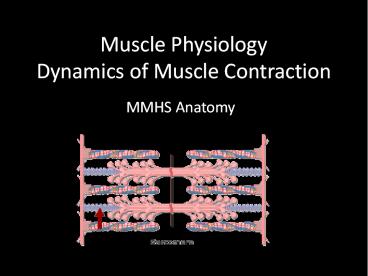Muscle Physiology Dynamics of Muscle Contraction - PowerPoint PPT Presentation
Title:
Muscle Physiology Dynamics of Muscle Contraction
Description:
Muscle Physiology Dynamics of Muscle Contraction MMHS Anatomy Thick and Thin Filaments A. Muscle movement (=contraction) occurs at the microscopic level of the sarcomere. – PowerPoint PPT presentation
Number of Views:405
Avg rating:3.0/5.0
Title: Muscle Physiology Dynamics of Muscle Contraction
1
Muscle PhysiologyDynamics of Muscle Contraction
- MMHS Anatomy
2
Thick and Thin Filaments
- A. Muscle movement (contraction) occurs at the
microscopic level of the sarcomere. - B. Sliding Filament Mechanism
- 1. Actin (thin) myofilament slides along the
myosin (thick) myofilament. - 2. Z lines that form the boundary of the
sarcomere move toward each other along the length
of the muscle. - this causes the muscle to shorten
(contractibility).
3
The Neuromuscular Junction
4
Muscle Cell Parts
- Sarcolemma the muscle membrane
- Sarcoplasm the muscle cytoplasm
- Sarcoplasmic reticulum organelle responsible
for protein production. - This contains high amounts of Ca2 ions.
5
Sarcomere Parts
- Z lines boundary of the sarcomere.
- I Band region of only actin myofilaments.
- H Zone region of only myosin myofilaments.
- A Band region of both actin and myosin.
- M-Line The exact midpoint of the sarcomere.
6
The Sarcomere
7
Muscle Contraction10 Steps
- A nerve impulse enters the presynaptic terminal
(nerve) of the neuromuscular junction. - The impulse causes Ach to be released from the
synaptic vessicles in the axon terminal. - Ach diffuses across the synaptic cleft and opens
Na channels in muscle membranes. - Na enters the muscle cell and depolarizes it.
- T tubules carry impulses into the sarcoplasmic
reticulum and releases Ca2 ions.
8
10 steps of Muscle Contraction
- Ca 2 enters the individual muscle fibrils and
binds to troponin molecules on tropomyosin
strands moving the strand and exposing the
binding sites. - Myosin binds to actin forming crossbridges that
ATP can bind to. - ATP breaks down, releasing energy, causing cross
bridges to pull actin strand.
9
10 steps of muscle contraction
- Another ATP binds to myosin cross bridge for the
recovery stroke. (bend, attach, and pull) on the
actin strand. - When the action potential ends Ca 2 ions are
pumped back into the sarco. retic. Tropomyosin
covers the binding sites and myosin can no longer
bind.
10
- The thin filament showing what happens when
Calcium binds. - Calcium binds to the troponin complex.
- 2. Tropomyosin moves exposing the binding sites.
- 3. Now exposed so the heads of the thick myosin
filament can bind to the actin.
11
The Myosin Cross-Bridge Formation
- Read the step-wise captions explaining how the
cross-bridge process works. - Identify
- Working stroke
- Recovery stroke
- Cross Bridge.
- ATP ADP
12
(No Transcript)































